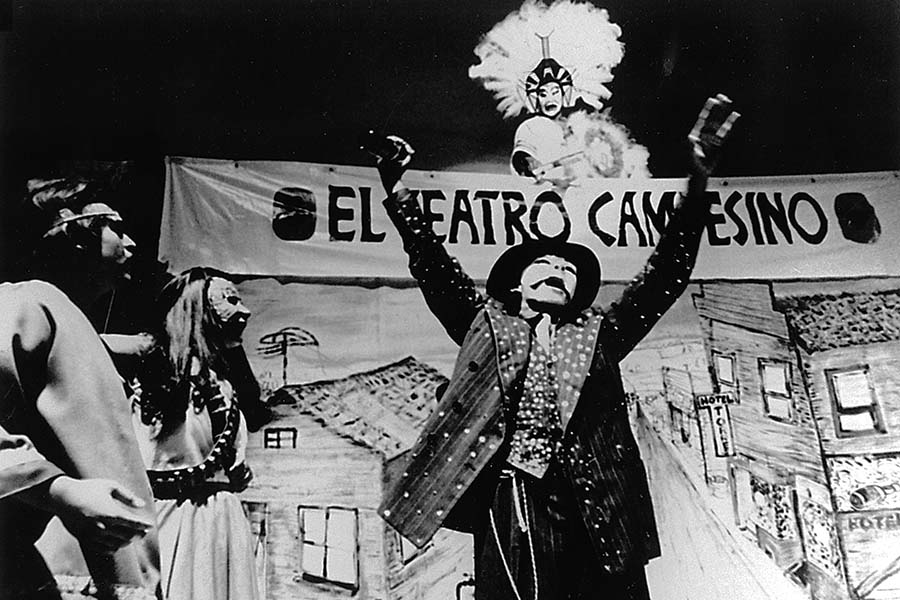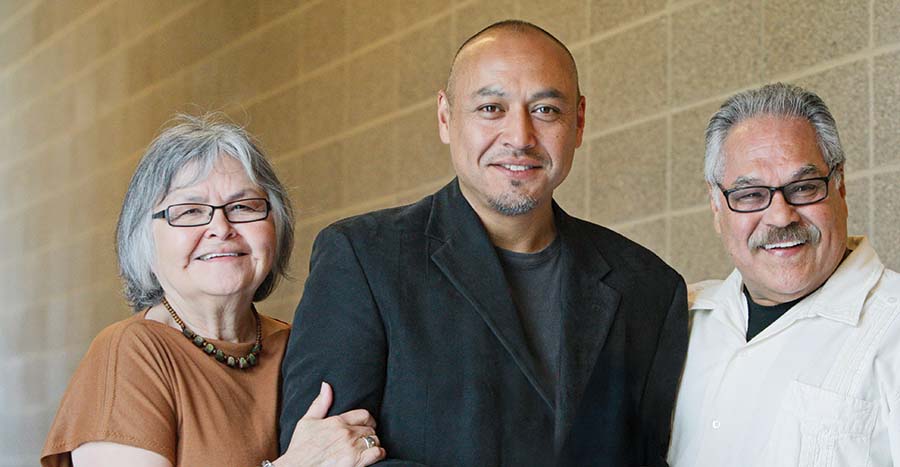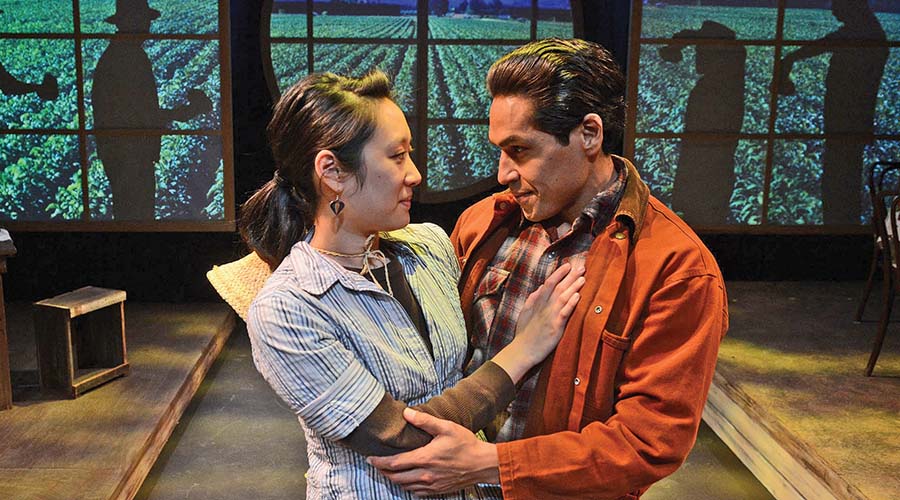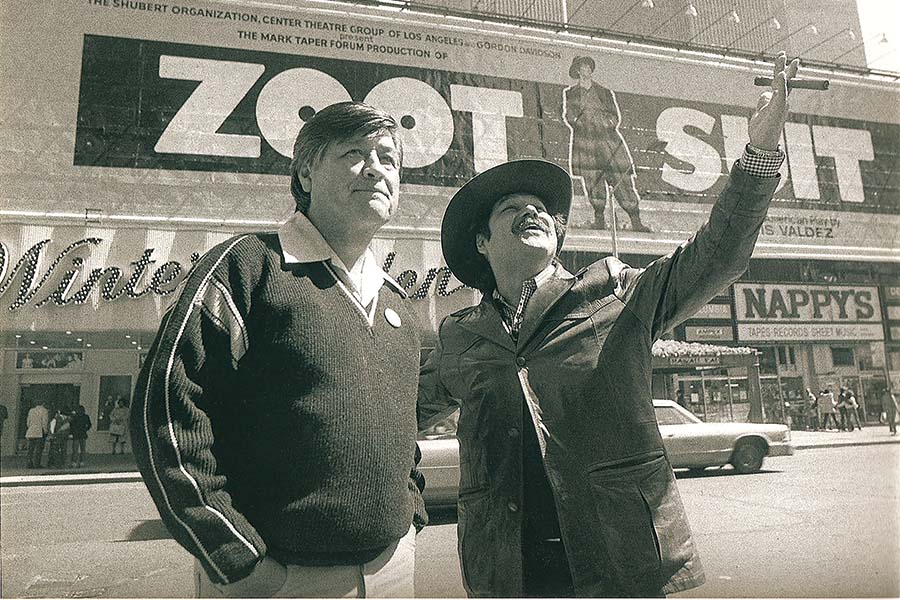In 1965, Luis Valdez and a group of farmworkers founded the first theatre of its kind in this country: a raggle-taggle troupe dedicated to educating farmworkers about the need for a union. These were actual campesinos, not actors, who were placing their lives on the line, literally and figuratively, performing collectively created sketches called actos under the leadership of a young, passionate soldier for social justice. In its first 15 years, El Teatro Campesino (literally “the farmworkers’ theatre”) evolved from these humble origins into a community-based/student group, then to an international touring company creating films, recordings, and anthologies, and finally to the professional producing organization it remains today. For 50 years the Teatro Campesino and its founding director and playwright have experienced an odyssey few theatre companies in this country have enjoyed.
The theatrical form that dominated the Teatro’s presentations from 1965 to 1970 was the acto, so named by Valdez for expediency’s sake. An acto is a short, usually comical sketch, often created through improvisation, designed to be performed anywhere. Actos were ideally suited for the Teatro’s initial efforts to get farmworkers to join the union Cesar Chavez and Dolores Huerta were founding. In the typical acto the heroes and villains are clearly defined and a solution is either hinted at or clearly stated: “Join the union,” “Boycott grapes,” etc.
Aesthetically the earliest Teatro Campesino actos were simple but not simplistic, inventive by necessity. Because the group had to be prepared to perform anywhere, usually outdoors, design elements came together by chance. Signs around the necks of the actors marked the characters clearly and masks further delineated the villain (pig face mask) from the heroes (no masks). Costumes were found and exaggerated; props were put together in somebody’s kitchen. This has been termed a rasquache aesthetic, referring to the working-class Mexicans’ term for something brash, unsophisticated, held together by spit and grit, as one negotiates the harsh realities of the working poor either in Mexico or “en el norte”—i.e., the U.S.

But in the Teatro’s first 15 years, the group developed other performance genres, all reflecting the rasquache aesthetic in one way or another: the mito, or myth, the corrido (a folk ballad about fighting injustice), and the carpa (literally “tent,” a variety performance intended for working-class audiences). The mito was Valdez’s effort to recover Chicanos’ lost indigenous heritage. The Teatro’s invocations of indigenous thought and culture can be seen in many of the plays written by Chicanas and Chicanos to this day.
Indeed, the Teatro’s sociopolitical legacy can be clearly seen in the various themes exposed by their actos, songs, and other performance techniques, in presentations across the country and even abroad, bringing the plight of the working class to a wide variety of audiences. The Teatro became a voice for the voiceless, giving Chicano audiences in particular a sense of belonging in a society that had ignored and suppressed them for generations. And everywhere the Teatro performed they inspired others to create their own teatros, thus widening the field. In 1969 the Teatro began to organize and host annual Chicano theatre festivals to promote the aesthetic and political development of these mainly student groups, exploring their roles as cultural workers. Within 10 years of its creation the Teatro Campesino had almost singlehandedly fostered a national theatre movement. By 1971 the Teatro was based in the small town of San Juan Bautista, Calif., where it continues to explore issues important to its heritage, giving the Chicana and Chicano a sense of place and a pride in who they are.
Chicana and Chicano theatre artists have come a long way since the early days. This professionalization of Chicano theatre can be attributed to individual efforts, certainly, but one cannot ignore the impact of Zoot Suit in this progress. Demographics and economics notwithstanding, Zoot Suit opened the doors to the mainstream; premiering in 1978 on the mainstage of the Mark Taper Forum, this musical-theatrical phenomenon retold the story of WWII-era riots in Los Angeles among Chicano youths called pachucos and white American servicemen (abetted by a biased, white-run judicial system) over a contested murder trial. It created a national sensation, though it fared less well in a 1979 Broadway run and 1981 film version, and inspired a new generation of performers and creators from the community.
Meanwhile the Teatro has its own generational story. It is very much a family affair in the tradition of the early Spanish-language theatre companies that toured to centers of Spanish-speaking people throughout the country. Kinan Valdez—Luis and Lupe Valdez’s middle son—has assumed the role of producing artistic director and is continuing the Teatro legacy as a brilliant director, actor, playwright, and producer in his own right.
I’ve been following and documenting the Teatro story since the beginning, and I recently sat down with Luis and Kinan in Los Angeles, where they were in town for pre-production meetings for the long-anticipated revival of Zoot Suit at Center Theatre Group’s Taper in early 2017 (Jan. 31-March 12).

JORGE A. HUERTA: When Zoot Suit was first produced in 1978, you declared that the play was “an American play.” Do you still believe you have to say that?
LUIS VALDEZ: Yes, because some people live in the present, some people live in the future, but most people live in the past. And the whole narrative of the American experience, of the American nation, needs to grow and change and evolve in the 21st century to allow Americans in all colors, from all religions, origins, and backgrounds subscribing to the fundamental issues of our country which are inscribed in the Constitution. The Constitution says nothing about color or language; it speaks about fundamental human rights that define America. It’s incumbent on all writers and people who tell stories of America to reexamine the idea of America. And if you’re talking about the basic issue of human rights, then the idea of America begins to shine.
HUERTA: Kinan, when you were beginning to take the reins of the Teatro in 2001, what was your greatest challenge as you stepped into your father’s formidable shoes?
KINAN VALDEZ: There came a time when my entire generation had to make a decision to become the Teatro Campesino, and we realized that we had to embody that skin—to carry it forward and continue the methodology. Even though we like to tell the story of the Teatro as centered on a couple of individuals, I think of myself as a member of a large, extended community of people who embrace the notion of the Teatro Campesino as their home. My first cherished memories of the Teatro are when we were on the road. When you are with your family, but only half or a quarter of them are related by blood, the experience is a powerful guiding principle of what people can accomplish when they come together and embrace themselves as a family.
HUERTA: The Teatro has attracted visionaries from around the globe. Who have been the most important influences in your development as an actor, director, and producer, besides your father?
KINAN: There are a bunch of people who rolled through San Juan Bautista during my childhood—people who were touched by the Teatro on their travels and somehow all made their pilgrimage to San Juan. The idea that these people would make this trek to a tiny town in the middle of rural California to me is an exceptional notion. So as I aged it was important to be around people like Culture Clash, who were just starting out—young playwrights that were being mentored or nurtured by the previous generations.
HUERTA: Speaking of the young playwrights, how do you develop new work at the Teatro?
KINAN: There are two pathways: We create spaces for those members of the company who have an interest in developing their voices as playwrights, and then there are outside playwrights who we invite to work with us. We are also heavily invested in the idea of the ensemble and collaboratively created work, and now in the American theatre they are talking about the rise of ensembles again. Though this is not something that is new to the Teatro, it is wonderful to tap into ensemble theatres that are out and about in the U.S. Those are different ways to explore what it means to create theatre.

HUERTA: Luis, how does that relate to Teatro’s earliest days?
LUIS: What we represented as a part of the union movement was the ability to give the tools to the farmworkers to express their ideas, to demonstrate their talent. You don’t have to have a college education to sing or to act. Our early motto was “No experience necessary.” El Teatro Campesino has always maintained that spirit, and we will continue to maintain that spirit for as long as we exist.
HUERTA: Have we gone from theatre for social change to theatre for social acceptance?
KINAN: When we do our community-engaged work, we are still very much aware of the impact that is being made in that particular moment for the people we are working with. It’s not about acceptance writ large; it is about empowering individuals to become all they can become. Right now we’re going through another shift within the Teatro. We have three different generations operating under the same roof within the same family, and we’re constantly having to negotiate, navigate the different impulses—the different expressions of what it means to be El Teatro Campesino. And the next generation has been heavily inspired by the motto “No experience required.”
HUERTA: Just like in the early days, long before you were born.
KINAN: That has become the driving force, the modus operandi for this new generation, who say, “Forget mainstream success. What matters to us is going into our community and having a real impact, changing people’s lives, just one person at a time.” And that was the organizing strategy of the UFW: You organize one person at a time. And so this is a way of speaking to the questions about social acceptance.
HUERTA: Your father was quoted in 1967 as saying that the Teatro is “somewhere between Brecht and Cantinflas.” Is this still the case?
KINAN: Absolutely. I don’t think it will ever move. It might oscillate, but the Teatro lives comfortably between those two poles. Because the experience of the resident company members speaks to the personal, and also in terms of Brecht’s use of experimental epic theatre that was counter to Aristotelian dramatic work. And Cantinflas is still very much a part of our humor, and also the embracing of popular theatre.
HUERTA: The Teatro Campesino has been described as having a rasquache aesthetic. Where do you see the Teatro’s style going?
LUIS: One of the defining characteristics of our work, rasquache or not, political or not, is that there always has to be a sense of joy in what we do. And from the earliest days that would be humor. And that energy and spirit, music always—these are joyous elements. The idea that you can turn a negative into a positive through some kind of alchemy of the theatre and the arts—that they leach out the bitterness of life. You can represent heartbreak, but if you keep it there, you’re going to lose your audience. They want to be resolved of that.
Turning negatives into positives is the function of art, and we see it as one of the fundamental functions of the theatre. We create community when we come together to do a play; it’s an occasion. Whether it’s family or people in the neighborhood or strangers, it doesn’t matter, you come together and you are a community at that play. You want that spell to be maintained while the show’s going on. Everybody’s just a little bit happier, uplifted from when they went in.
HUERTA: In the early years, the Teatro Campesino exposed and explored farmworkers’ reality, as opposed to the experiences of urban Chicanas and Chicanos, as Zoot Suit did. How has this balance changed over the years?
KINAN: Actually the original Teatro wasn’t a Chicano theatre—it was a worker’s theatre. So when you are consciously looking beyond those boundaries in order to build commonality, that’s going to stay with you as part of the company. You’re always reaching out to build those coalitions, and that is something that defines the work of my father: Build connections, that common humanity, while at the same time always having a very specific base and perspective.
HUERTA: There is a great interest and excitement about Zoot Suit’s revival, but I’ve expressed concern that audiences might see it as dramatizing problems that no longer exist. Is that something you’ve thought about?
KINAN: When we chose to produce Zoot Suit at the Teatro in 2002 it was after 9/11, after the Afghan War had begun and shortly before the Iraq War, and we became aware that history was repeating itself. We realized we were in the midst of another Zoot Suit-like moment, and that an entire people were going to be scapegoated because of the way they looked and dressed. It became very clear to us that Zoot Suit was unfortunately something that was going to live on, beyond just a tale about Chicanos living in Los Angeles in the 1940s, but a tale of being “othered.” How L.A. sees it this time remains to be seen. But for anyone who engages with the justice system the play becomes very timely, unfortunately.
LUIS: Zoot Suit is a quintessential Los Angeles play. It touches on a period way back at the beginning of WWII when L.A. was coming into being, in the sense that the movies were here, radio and TV broadcasting, and that’s what we’re dealing with this time around. The world that existed from about the 1920s to the 1950s—that whole world is a transitional world that Chicanos went into as if it was “magic land.” They had come from immigrant families in Mexico that lived nowhere near cities. So all these young Chicanos had to learn a new style on their own. They had to adapt. Thus the zoot suit, the short skirt. This became dangerous because it was something that flew in the face of a more subdued, conservative spirit in America. But it was happening in L.A.; L.A. as a place has been a dynamic cultural breeding ground of a lot of American attitudes that we now take for granted. I think that L.A. made the Chicano possible. This time around, almost 40 years after the original production, it’s going to be a very interesting time for me to see the audiences, to see how they react.
HUERTA: Kinan, you’ve directed this play three times in a variety of venues. Do you believe, as I do, that the play is a classic?
KINAN: The play’s the star, and every time we or anybody mounts it, Zoot Suit resonates with audiences because it’s good theatre.
HUERTA: Luis, what was it like directing the play in Mexico in 2010?
LUIS: I’m a Mexican there, but I also bring to the table my American experience, and they love that. They wanted to know about our experiences as Chicanos. Hopefully what we will retain is the spirit, regardless of what language it is in. It is our optimism, our Americanism, we can take to Mexico and they will absorb. I had no problem directing Mexicans. I think that’s part of the future: American playwrights, starting with the Latinos, looking toward Latin America, finding a huge world that they could be part of.
HUERTA: What about the language, the code-switching in Zoot Suit—was that a problem in Mexico? Did you study Spanish formally as a youth?
LUIS: In college in the ’60s I took some Spanish classes, literature and some of that stuff. Once the Chicano movement got going, I found that I needed to pay more attention to the terminology, to be hip. When I first went to Mexico City in 1963, people would listen to me speaking Spanish and they would say: “You talk like my grandfather,” because I was speaking my grandfather’s Spanish. He came across at the turn of the century, so they’d say, “Man, you talk old-fashioned—we haven’t heard those words in a long time.” So obviously I had to come up to speed. And that was part of the process of adapting Zoot Suit into Spanish to make it the same tempo while at the same time making it “cool.”
HUERTA: Are there any changes that you made in the Mexican production that will be useful in this revival?
LUIS: I’ve begun to pay a lot more attention to the pachucas—the women were victims just as much as the men.
KINAN: In this production are two songs that the movie contained that were not in the original production. I think it’s very much like Cabaret: Any production of Cabaret has to contend with the film version and inevitably incorporate songs from the movie. Zoot Suit has had that same relationship with its own songs, so this will feature two production numbers that were not in the original stage play.
HUERTA: Are you putting more English into this revival?
LUIS: Not necessarily. There never was all that much Spanish. There was more Spanish in the first act than in the second, so people would go away saying, “I’m learning to understand Spanish, because by the second act I could really understand everything!”
HUERTA: Is there a thought of taking the play back to Broadway?
LUIS: I’ve heard some people hinting, and we’ve had extended conversations with Oskar Eustis at the Public Theater. If it does happen, it will be because the country has changed enough to allow it to last for a while. I think that American theatre, as well as the country as a whole, needs a new narrative. Where are we going with all of this—where is it going? And as far as I’m concerned we either uplift the entire American people or it can come crashing down.
Jorge A. Huerta, Ph.D., is Chancellor’s Associates Professor of Theatre, emeritus, at the University of California, San Diego.




